She did as he ordered, and he proceeded to tie her wrists together and to fasten them to the back of the chair on which she had seated herself. He was careful not to draw the cords too tight, but at the same time he made the fastening secure.
“You won’t disturb mother, will you?” she asked quietly when he had finished. “Her room’s the one at the end of the passage.”
“I don’t want to disturb any one,” he answered. “I only want to get off quietly. I won’t gag you, but don’t you try to make any noise, if you do I’ll come back. Understand?”
“Oh, perfectly,” she answered. “May I ask one question? Do you feel very proud of yourself just now?”
He did not answer, but went out of the room quickly, and he had an impression that she smiled as she watched him go, and that her smile was bitter and a little contemptuous.
“What a girl,” he muttered. “She scored every time. I didn’t find out a thing, she didn’t do anything I expected or wanted her to. She seemed as if she spotted me right off—I wonder if she did? I wonder if she could be trusted?”
But then he thought of that photograph on the mantelpiece and his look grew stern and hard again. He was careful to avoid the room the girl had indicated as occupied by her mother, but of all the others on that floor he made a hasty search without discovering anything to interest him or anything of the least importance or at all unusual.
From the wide landing in the centre of the house a narrow stairway, hidden away behind an angle of the wall so that one did not notice it at first, led above to three large attics with steeply-sloping roofs and evidently designed more for storage purposes than for habitation.
The doors of two of these were open and within was merely a collection of such lumber as soon accumulates in any house.
The door of the third attic was locked, but by aid of the jemmy he still carried, he forced it open without difficulty.
Within was nothing but a square packing-case, standing in the middle of the floor. Otherwise the light of the electric torch he flashed around showed only the bare boarding of the floor and the bare plastered walls.
Near the packing-case a hammer and some nails lay on the floor and the lid was in position but was not fastened, as though some interruption had occurred before the task of nailing it down could be completed.
Dunn noted that one nail had been driven home, and he was on the point of leaving the attic, for he knew he had not much time and hoped that downstairs he would be able to make some discoveries of importance, when it occurred to him that it might be wise to see what was in this case, the nailing down the lid of which had not been completed.
He crossed the room to it, and without drawing the one nail, pushed back the lid which pivoted on it quite easily.
Within appeared a covering of coarse sacking. He pulled this away with a careless hand, and beneath the beam of his electric torch showed the pale and dreadful features of a dead man—of a man, the center of whose forehead showed the small round hole where a bullet had entered in; of a man whose still-recognizable features were those of the photograph on the mantel-piece of the room downstairs, the photograph that was signed:




